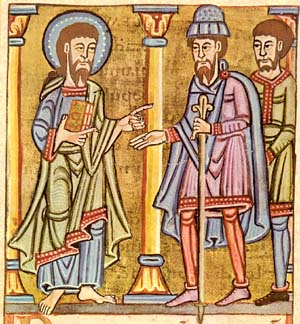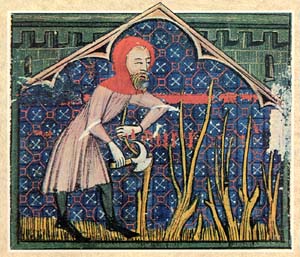 |
The Saint of the Day
St. Alexander the Charcoal-Burner,
August 11
Prof. Plinio Corrêa de Oliveira
Biographical selection:
In the mid-third century the Christians of Comana, in Pontus, sent representatives to St. Gregory Thaumaturgus, Bishop of Neocaesarea, requesting a Bishop for their city. So St. Gregory went to Comana to look for a shepherd for the new Diocese.
A city commission had sought out candidates of noble birth, great eloquence, or other such qualities. When all these were presented to him, St. Gregory advised the commission that they should consider virtue first, and not despise those of more humble appearance. One of these officials, deriding the counsel of St. Gregory, replied: ‘If you don’t want one from among our most distinguished citizens, perhaps we should choose a Bishop from among the plebeians. In this case, I counsel you to bring forth Alexander the charcoal-burner so that we can all acquiesce in the matter.’

“So St. Gregory went to Comana to look for a shepherd for the new Diocese.”
|
St. Gregory asked: “Who is this Alexander?” Laughing, they brought Alexander to him.
Because of the charcoal dust, his face, hands, and modest clothing were black with dirt. The assembly laughed at seeing such a figure among the candidates for Bishop. Alexander remained self-composed, unembarrassed at his modest condition. In fact, contrary to appearances, he was a gifted philosopher, a truly wise man. It was not need that caused him to take up that profession, but his will to practice a life of virtue removed from public admiration. Young and handsome, he desired to live chastely avoiding occasions of sin. The charcoal dust disguised his face and, like a mask, prevented his features from being noticed. The work provided just enough for him to live and practice small works of charity.
St. Gregory ordered Alexander to take a bath and put on his own episcopal robes. In a short time, a completely different man appeared, attracting the attention of all who were assembled there. St. Gregory told them: “Do not be surprised if you were fooled in your judgment, which you only made according to what you could see. The Devil wanted to hide this vessel of election and keep him from being a Bishop.”
He consecrated Alexander as Bishop. In his first sermon, Alexander astonished the whole assembly with the wisdom and eloquence of his words. An Athenian who was present criticized him for lacking Greek elegance, but was reprehended by an apparition.
St. Alexander became famous for his preaching and governed the church of Comana in a dignified way until the persecution under Emperor Decius, when he was burned to death, dying a martyr for the Catholic Faith.
Comments of Prof. Plinio:

A charcoal burner cuts wood and burns it until it is transformed into charcoal.
| |
It is a very beautiful life! One could say that in this life one wonder is added to another. The handsome young man was at the same time a skilled philosopher, a truly wise man who had decided to flee the world. He went to the small town of Comana and became a charcoal-burner.
The profession of charcoal-burner is a very humble profession. It consists of cutting wood, burning it until it is transformed into charcoal, then stopping the burning process, and selling the charcoal. Because of the dust of the charcoal, the man who works at this profession is completely dirty, completely black.
So, St. Alexander decided to be a charcoal-burner to disguise his features and avoid admiring eyes. Doing that, he had to work hard at a job that kept him poor, but he lived innocent without occasion of sin. And so he lived there in Comana in his world divided between charcoal and philosophy.
You can imagine what the end of a day would be like for St. Alexander. After returning from a day of hard work, he sits outside his modest house, situated at a point where the open field ends and the forest where he cuts his wood begins. He sits in silence; it is hot; some simple food is cooking on the stove. While he waits, he thinks, he makes distinctions, he raises abstract questions, he constructs intellectual edifices until he reaches the heights of theology.
While he thinks, he prays to Our Lady. It is time to go in and eat. After the simple meal he goes to a church to visit the Blessed Sacrament, to visit a special statue of Our Lady that he likes. Then he returns and has a chaste, pious and tranquil night in his little Comana. When one compares his life with our lives in this revolutionary world, one has a serious inclination to leave aside everything modern and go off to a retired place to live a life like that of St. Alexander.
Well, there he was following a normal day’s routine when he was called to come before an assembly. It was an extraordinary thing for him. He arrived at the assembly and people began to laugh at him. He didn’t mind. He was secure and content about who he was and what he was doing. He was a man who practiced what the Imitation of Christ teaches us to do: To be happy to be ignored and considered as nothing in the eyes of the world.
He was there, composed and happy, probably admiring the great St. Gregory Thaumaturgus who was present. Thaumaturgus is a Greek word that means ‘one who works miracles.’ You can easily image the great eminence of St. Gregory, famous for his miracles – incomparably more than any of the small celebrities of Comana who had gathered there. What the text does not say, but what is very probable to have happened, is that the two saints immediately discerned the sanctity and the human value of one another. When St. Gregory first heard about St. Alexander, he probably had a premonition telling him who he was. So, he was checking the man. It did not take very long for St. Gregory to confirm his presentiment. He was right. He ordered that a bath be given to St. Alexander and his own episcopal clothing be placed on him.
A short time passed, and St. Alexander re-entered, but now he was a svelte, distinguished and spotless man wearing episcopal robes. He was consecrated Bishop and gave a sermon that astonished those present by its profound thought and elegant form. Only a pompous Athenian criticized it, saying it did not follow the Greek style. It was only reasonable that St. Alexander’s style should not necessarily be Greek, since he was not a Greek. At any rate, a vision from heaven reprehended the man, and that put a stop to his criticisms.
How did this life end? It ended in martyrdom. He was called to shed his blood in holocaust to Our Lord Jesus Christ and as testimony to his adhesion to the Catholic Faith. He went from being covered with black charcoal dust to being drenched in the red blood of martyrdom. How admirable!
It is a life that shines with the marvelous. Today we live in a revolutionary world that has turned its back on the marvelous. Everything is banal, empty, and insipid, even when it is not something that is an occasion of sin. Today the only marvelous thing that exists is the fidelity of some Catholics who did not bend their knees before the revolutionary idols. It is the only thing that exudes a precious perfume amidst a putrid ambience, that shines like a bright light in the darkness, that is noble and worthy of respect in a vile environment. It is a lily that blooms in the muck of a dark stormy night.
Let us ask St. Alexander to give us the plenitude of his marvelous spirit so that we might be transformed into the true Apostles of the Last Times described by St. Louis de Montfort.


  | | Prof. Plinio Corrêa de Oliveira | |
The Saint of the Day features highlights from the lives of saints based on comments made by the late Prof. Plinio Corrêa de Oliveira. Following the example of St. John Bosco who used to make similar talks for the boys of his College, each evening it was Prof. Plinio’s custom to make a short commentary on the lives of the next day’s saint in a meeting for youth in order to encourage them in the practice of virtue and love for the Catholic Church. TIA thought that its readers could profit from these valuable commentaries.
The texts of both the biographical data and the comments come from personal notes taken by Atila S. Guimarães from 1964 to 1995. Given the fact that the source is a personal notebook, it is possible that at times the biographic notes transcribed here will not rigorously follow the original text read by Prof. Plinio. The commentaries have also been adapted and translated for TIA’s site.
|
Saint of the Day | Home | Books | CDs | Search | Contact Us | Donate

© 2002- Tradition in Action, Inc. All Rights Reserved
|
 |

|